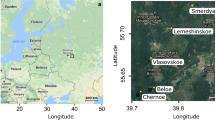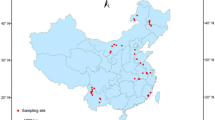Abstract—
The first data on the species diversity of testate amoebae of the Coco River in the provinces of Quang Nam and Da Nang (Vietnam) are presented. A total of 55 species and subspecies of testate amoebae belonging to nine genera and six families have been identified in 28 samples. Species diversity of testate amoebae in plankton is higher than in benthic samples. Centropyxis aculeata (64.3%), Netzelia wailesi (39.3%), Difflugia acuminata (32.1%), Arcella discoides scutelliformis (28.6%), and Lesquereusia modesta (28.6%) are characterized by the highest frequency of occurrence. Difflugia (25), Arcella (12), Centropyxis (5), and Netzelia (4) are the most species-rich genera. The species accumulation curve based on the entire dataset is unsaturated and is described by the equation y = 12.56N0.46. The average species richness of testate amoebae per sample in plankton (13.0 ± 3.1) is statistically higher than in benthic samples (1.8 ± 1.5) (p < 0.001). The result of the redundancy analysis shows that the studied hydrochemical water parameters (temperature, pH, dissolved oxygen, electrical conductivity, and salinity) explain only 31.6% of the variation of testate amoeba diversity; the first and second axes explain 11 and 10.2% of this variation, respectively.



Similar content being viewed by others
REFERENCES
Gilbert, D., Amblard, C., Bourdier, G., and Francez, A.J., The microbial loop at the surface of a peatland: Structure, function, and impact of nutrient input, Microb. Ecol., 1998, vol. 35, no. 1, pp. 83–93.
Mieczan, T. and Tarkowska-Kukuryk, M., Diurnal dynamics of the microbial loop in peatlands: Structure, function and relationship to environmental parameters, Hydrobiologia, 2013, vol. 717, no. 1, pp. 189–201.
Payne, R.J., Seven reasons why protists make useful bioindicators, Acta Protozool., 2013, vol. 52, no. 3, pp. 105–113.
Marcisz, K., Colombaroli, D., Jassey, V.E.J., Tinner, W.P., Kołaczek, P., Gałka, M., Karpińska-Kołaczek, M., Słowiński, M., and Lamentowicz, M., A novel testate amoebae trait-based approach to infer environmental disturbance in Sphagnum peatlands, Sci. Rep., 2016, vol. 6. https://doi.org/10.1038/srep33907
Tsyganov, A.N., Babeshko, K.V., Novenko, E.Yu., Malysheva, E.A., Payne, R.J., and Mazei, Yu.A., Quantitative reconstruction of peatland hydrological regime with fossil testate amoebae communities, Russ. J. Ecol., 2017, vol. 48, no. 2, pp. 191–198.
Seppey, C.V.W., Fournier, B., Szelecz, I., Singer, D., Mitchell, E.A.D., and Lara, E., Response of forest soil euglyphid testate amoebae (Rhizaria: Cercozoa) to pig cadavers assessed by high-throughput sequencing, Int. J. Legal Med., 2016, vol. 130, no. 2, pp. 551–562.
Swindles, G.T. and Ruffell, A., A preliminary investigation into the use of testate amoebae for the discrimination of forensic soil samples, Sci. Justice, 2009, vol. 49, no. 3, pp. 182–190.
Szelecz, I., Fournier, B., Seppey, C., Amendt, J., and Mitchell, E., Can soil testate amoebae be used for estimating the time since death? A field experiment in a deciduous forest, Forensic Sci. Int., 2013, vol. 236, pp. 90–98.
Balik, V., Testate amoebae (Protozoa: Rhizopoda) from a primary mountain rain forest in the Tam-Dao region (Vietnam), Acta Soc. Zool. Bohemoslov., 1995, vol. 59, no. 1, pp. 1–16.
Bobrov, A.A., Mazei, Y.A., and Tiunov, A.V., Testate amoebae of a monsoon tropical forest of South Vietnam, Acta Protozool., 2010, vol. 49, no. 4, pp. 311–325.
Golemansky, V., Thécamoebiens psammobiontes du supralittoral vietnamien de La Mer Chinoise et description de Cryptodifflugia brevicolla sp. n. (Rhizopoda: Arcellinida), Acta Protozool., 1979, vol. 18, no. 2, pp. 285–292.
Nguyen, V.H., Bernard, N., Mitchell, E.A.D., Cortet, J., Badot, P.M., and Gilbert, D., Relationship between testate amoeba (Protist) communities and atmospheric heavy metals accumulated in Barbula indica (Bryophyta) in Vietnam, Microb. Ecol., 2007, vol. 53, no. 1, pp. 53–65.
Shirota, A., The Plankton of South Viet-Nam: Fresh Water and Marine Plankton, Overseas Technical Cooperation Agency, 1966.
Tran, Q.H., Diversity and community patterns of testate amoebae in Bau Sen and Bau Trang Lakes in Binh Thuan Province, Vietnam, Inland Water Biol., 2017, vol. 10, no. 1, pp. 1–7.
Kudo, R.R., Protozoology. Handbook of Protozoology, Springfield, Baltimore: Charles C. Thomas Publ., 1939.
Charman, D.J., Hendonand, D., and Woodland, W.A., The identification of testate amoebae (Protozoa: Rhizopoda) in peats, QRA Technical Guide No. 9, London: Quaternary Research Association, 2000.
Mazei, Yu.A. and Tsyganov, A.N., Presnovodnye rakovinnye ameby (Freshwater Testate Amoeba), Moscow: Tovarishchestvo nauch. izd. KMK, 2006.
Ekologiya vnutrennikh vod V’etnama (Ecology of Inland Waters of Vietnam), Pavlov, D.S. and Zvorykin, D.D., Eds., Moscow: Tovarishchestvo nauch. izd. KMK, 2014.
Snegovaya, N. and Alekperov, I., Fauna of testate amoebae of western Azerbaijan rivers, Protistology, 2005, vol. 4, no. 2, pp. 149–183.
Holcova, K., Thecamoebians from the Upper Vltava river (Šumava Mountains, Czech Republic): Species composition of assemblages vs. environment in streams, J. Foraminaferal Res., 2007, vol. 37, no. 4, pp. 287–299.
Mazei, Yu.A. and Tsyganov, A.N., Testate amoeba in aquatic ecosystems of the Sura River floodplain (Middle Volga). 1. Fauna and morphoecological features of species, Zool. Zh., 2006, vol. 85, no. 11, pp. 1267–1280.
Alves, G.M., Velho, L.F.M., Simoes, N.R., and Lansac-Tôha, F.A., Biodiversity of testate amoebae (Arcellinida and Euglyphida) in different habitats of a lake in the Upper Paraná River floodplain, Eur. J. Protistol., 2010, vol. 46, no. 4, pp. 310–318.
Farooqui, A., Fresh water thecamoebians: Ecological indicators of seasonally induced hydrological changes in lakes, Ekol. Noosferol., 2009, vol. 20, nos. 3–4, pp. 117–123.
Lamentowicz, L., Gabka, M., Rusinska, A., Sobczynski, T., Owsianny, P.M., and Lamentowicz, M., Testate amoeba (Arcellinida, Euglyphida) ecology along a poor-rich gradient in fens of Western Poland, Int. Rev. Hydrobiol., 2011, vol. 96, no. 4, pp. 356–380.
ACKNOWLEDGMENTS
I would like to thank D.V. Tikhonenkov for the help in preparing the manuscript and valuable advice.
Funding
This study was supported by the Joint Russian-Vietna-mese Tropical Research and Technological Center (grant no. 275/QĐ-CNVB).
Author information
Authors and Affiliations
Corresponding author
Ethics declarations
Conflict of interest. The author declares that he has no conflicts of interest.
Ethical statement. This article does not contain any studies with human participants or animals performed by the author.
Additional information
Translated by N. Ruban
About this article
Cite this article
Tran, Q.H. The First Data on Testate Amoebae in the Coco River in Quang Nam and Da Nang Provinces, Vietnam. Moscow Univ. Biol.Sci. Bull. 74, 207–214 (2019). https://doi.org/10.3103/S0096392519040023
Received:
Revised:
Accepted:
Published:
Issue Date:
DOI: https://doi.org/10.3103/S0096392519040023




